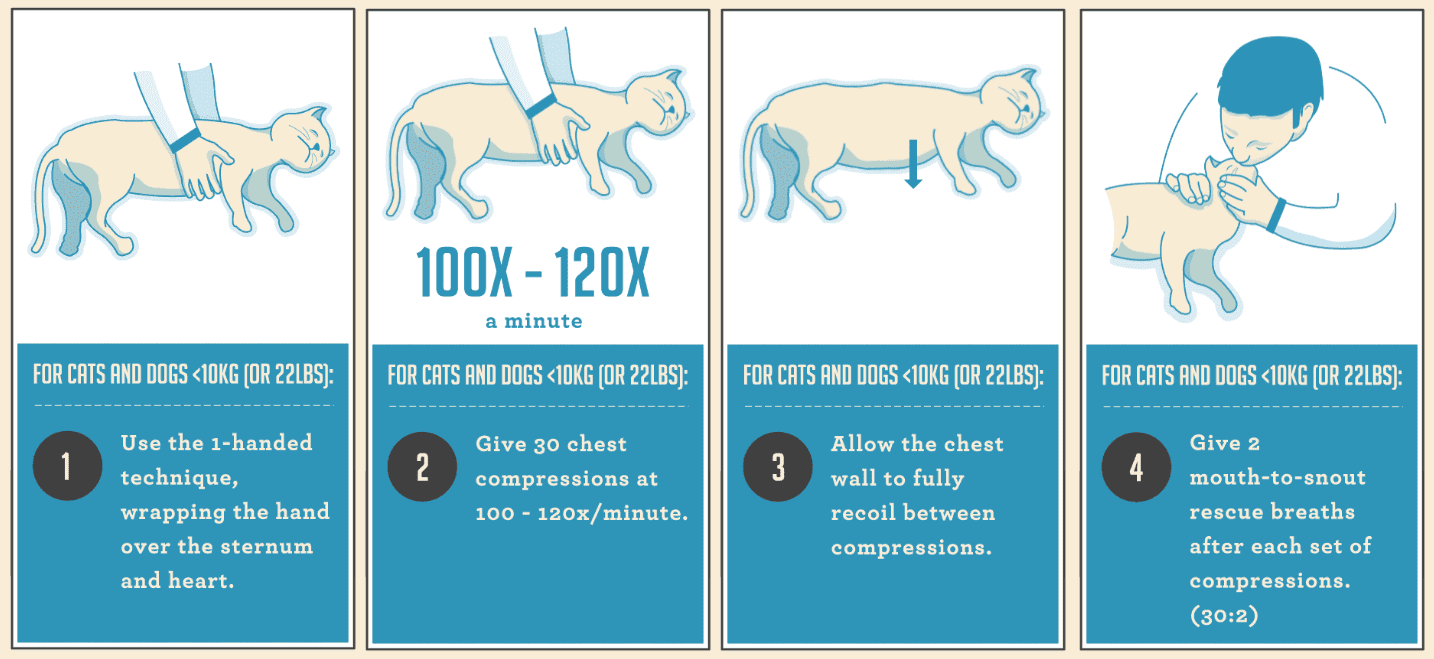I think we all know what CPR, or Cardiopulmonary resuscitation is. It is a life-saving procedure that humans perform during emergencies, which is something I hope you will never have to use. CPR is a pretty useful skill, especially if you have a family to care for. Family, including Your cats or dogs. 🙂
Why is it important to know CPR?
CPR could save a life if performed correctly. Most people know how to perform CPR on humans but what about pets? Pet emergencies can happen anytime and if you have CPR skills, you could provide immediate care and potentially save your pet’s life. Not only that, you can also strengthen your bond with your furbabies! Learning CPR for your pet can help you to feel more prepared and confident to handle any situation that might arise.
When to perform CPR on my pets?
There are definitely signs to look out for if you are not sure when to perform CPR on your pets. There are different symptoms when it comes to dogs and cats.
Symptoms for Dogs:
- Pale gums
- Weak pulse
- Rapid breathing
- Trouble standing
- Seizures
If you are able to bring your canine to the nearest vet, get them there as fast as possible but if your dog is distressed, it would be best to call for help.
Symptoms for Cats
- Difficulty breathing
- Lethargy
- Sudden and severe onset of illness (vomiting or diarrhoea)
- Sudden change of behaviours
The biggest telltale sign is when they are not breathing and are unconscious. This is when you should immediately go to the nearest 24-hour vet or call your vet with house call services and start performing CPR on your pets in the meantime.
How to perform CPR on a cat?

- If your cat is not breathing, open the mouth and see if you can spot any obstructions in the airway. Only do this if the cat is unconscious.
- Pull the cat’s tongue to the front of the mouth and close the mouth. Gently hold your cat’s mouth shut.
- Then, make sure the feline’s neck is straight. Breathe short puffs of air into their nose; one breath every 4-5 seconds.
- After 3-5 breaths, check if the feline’s heart is beating and if it is breathing again. If there are heartbeats but no breathing, continue the previous steps at a rate of 10 breaths per minute.
- However, if there are no heartbeats, lay your cat on its side on a flat surface.
- Hold your cat’s chest with 1 hand by putting your thumb and fingers on either side of its chest, behind the elbows and over the heart.
- Give a quick squeeze to compress the cheat to about ⅓ of its normal thickness.
- Continue the compression 1-00-120 times per minute, giving 2 breaths for every 30 compressions.
How to perform CPR on a dog (small and large breed)?

- If your dog is unresponsive and not breathing, start to perform chest compressions.
- Lay the dog on its right side on a flat surface and kneel beside them.
- For smaller dogs, place your thumb and fingers around the rib cage.
- For larger dogs bigger than 13kg, place the heel of your interlocked hands on the widest part of their rib cage.
3. Then, support the dog's back with your other hand and compress the chest, then release. Repeat the compressions at a rate of 100-120 per minute.
- For smaller dogs, use your thumb and fingers to press the chest 1/3 of the way down.
- For larger dogs bigger than 13kg, press the chest 1/4 of the way down.
Tips: To stay in rhythm, sing the song “Staying Alive” and press down on each “ah” in the song.
- After 30 chest compressions, perform two rescue breaths by closing the dog's mouth, placing your mouth over the dog's nose, and exhaling to inflate the dog's lungs. Watch for the chest to rise and fall.
- Continue compressions and breaths periodically every 2 minutes until the dog begins breathing on their own.
If they're breathing now, what do I do?
If you have been performing CPR on your pets and now they are finally breathing, bring them to the vet immediately. Remember when I mentioned you have to perform CPR while going to the vet or waiting for the vet to come over? This is exactly why. Your pets starting to breathe does not mean they are not in danger anymore. Always check in with the vet so they know what your furbabies need in times of emergencies.
If they’re not breathing, when to know to stop trying?
There really are no rules saying you should stop after multiple tries. However, the American Red Cross Training Services recommend not stopping until you have reached a vet clinic. The vet should know what to do once your pets are there.
Despite the effort, there are some studies that show CPR might not be enough to sustain life in a pet. The current success rate in the vet population varies from 6% to 8% only. This is mostly because the pets might already have severe illnesses prior to the procedure. Do you know we also have this article that shares about pet cremation services in Malaysia?
Nonetheless, it is still worth the effort for us to learn how to perform CPR in case of emergencies. This brings me to the topic of being prepared at all times. Why wait until emergencies happen then only do you regret not having any insurance for your furbabies. CPR or any procedure can be very costly for you and your pets. Why not prepare yourself for any sort of situation by getting pet insurance? This way, you can have peace of mind not having to worry about the money you might have to pay. You can check out our packages here!










%20(7).png)

%20(38).png)
%20(36).png)
%20(26).png)


